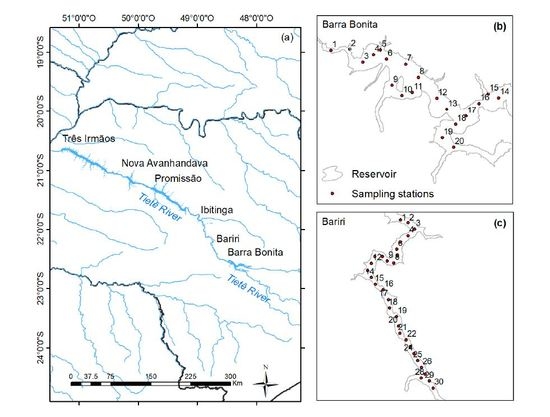Estimation of Chlorophyll-a Concentration from Optimizing a Semi-Analytical Algorithm in Productive Inland Waters
Abstract
:1. Introduction
2. Materials and Methods
2.1. Study Area and Sampling
2.2. Remote Sensing Reflectance, Rrs
2.3. Laboratory Measurements
2.3.1. OSC Concentration
2.3.2. Absorption Coefficients
2.4. Parameterization of the Semi-Analytical Algorithm
2.4.1. Estimation of SIOPs
2.4.2. Factors of Light Geometry
2.4.3. Inversion of the Semi-Analytical Algorithm
2.5. Assessment of the Semi-Analytical Algorithm
3. Results
3.1. Water Quality Characterization
3.2. Optical Properties
3.3. Ratio of Light Field and Distribution Light Factors, γ
3.4. Inversion of Semi-Analytical Algorithm
3.5. Estimation of Chl a Concentration
4. Discussion
5. Conclusions
Acknowledgments
Author Contributions
Conflicts of Interest
References
- Brando, V.E.; Dekker, A.G. Satellite hyperspectral remote sensing for estimating estuarine and coastal water quality. IEEE Trans. Geosci. Remote Sens. 2003, 41, 1378–1387. [Google Scholar] [CrossRef]
- Watanabe, F.S.Y.; Alcântara, E.; Rodrigues, T.W.P.; Imai, N.N.; Barbosa, C.C.F.; Rotta, L.H.S. Estimation of chlorophyll-a concentration and the trophic state of the Barra Bonita hydroelectric reservoir using OLI/Landsat-8 images. Int. J. Environ. Res. Public Health 2015, 12, 10391–10417. [Google Scholar] [CrossRef] [PubMed]
- Salem, S.I.; Strand, M.H.; Higa, H.; Kim, H.; Kazuhiro, K.; Oki, K.; Oki, T. Evaluation of MERIS chlorophyll-a retrieval processors in a complex turbid lake Kasumigaura over a 10-year mission. Remote Sens. 2017, 9, 1022. [Google Scholar] [CrossRef]
- Kirk, J.T.O. Light and Photosynthesis in Aquatic Ecosystems, 3rd ed.; Cambridge University Press: Cambridge, UK, 2011; pp. 199–261. ISBN 978-0-521-15175-7. [Google Scholar]
- Campbell, G.; Phinn, S.R.; Dekker, A.G.; Brando, V.E. Remote sensing of water quality in an Australian tropical freshwater impoundment using matrix inversion and MERIS images. Remote Sens. Environ. 2011, 115, 2402–2414. [Google Scholar] [CrossRef] [Green Version]
- Richardson, L.L. Remote sensing of algal bloom dynamics: New research fuses remote sensing of aquatic ecosystems with algal accessory pigment analysis. Bioscience 1996, 46, 492–501. [Google Scholar] [CrossRef]
- Gordon, H.R.; Brown, O.B.; Evans, R.H.; Brown, J.W.; Smith, R.C.; Baker, K.S.; Clark, D.K. A seminalytical radiance model of ocean color. J. Geophys. Res. 1988, 93, 10909–10924. [Google Scholar] [CrossRef]
- Mobley, C.D. Light and Water: Radiative Transfer in Natural Waters; Academic Press: San Diego, CA, USA, 1994. [Google Scholar]
- Hoge, F.E.; Lyon, P.E. Satellite retrieval of inherent optical properties by linear matrix inversion of oceanic radiance models: An analysis of model and radiance measurement errors. J. Geophys. Res. 1996, 101, 16631–16648. [Google Scholar] [CrossRef]
- Maritorena, S.; Siegel, D.A.; Peterson, A.R. Optimization of a semianalytical ocean color model for global-scale applications. Appl. Opt. 2002, 41, 2705–2714. [Google Scholar] [CrossRef] [PubMed]
- Yang, W.; Matsushita, B.; Chen, J.; Fukushima, T. Estimating constituent concentrations in case II waters from MERIS satellite data by semi-analytical model optimizing and look-up tables. Remote Sens. Environ. 2011, 115, 1247–1259. [Google Scholar] [CrossRef] [Green Version]
- Li, L.; Li, L.; Shi, K.; Li, Z.; Song, K. A semi-analytical algorithm for remote estimation of phycocyanin in inland waters. Sci. Total Environ. 2012, 435–436, 141–150. [Google Scholar] [CrossRef] [PubMed]
- Brando, V.E.; Dekker, A.G.; Park, Y.J.; Schroeder, T. Adaptive semianalytical inversion of ocean color radiometry in optically complex waters. Appl. Opt. 2012, 51, 2808–2833. [Google Scholar] [CrossRef] [PubMed]
- Pyo, J.C.; Pachepsky, Y.; Baek, S.S.; Kwon, Y.S.; Kim, M.J.; Lee, H.; Park, S.; Cha, Y.K.; Ha, R.; Nam, G.; et al. Optimizing semi-analytical algorithms for estimating chlorophyll-a and phycocyanin concentrations in inland waters in Korea. Remote Sens. 2017, 9, 542. [Google Scholar] [CrossRef]
- Brando, V.E.; Anstee, J.M.; Wetttle, M.; Dekker, A.G.; Phinn, S.R.; Roelfsema, C. A physcis based retrieval and quality assessment of bathymetry from suboptimal hyperspectral data. Remote Sens. Environ. 2009, 113, 755–770. [Google Scholar] [CrossRef]
- Rodrigues, T.; Alcântara, E.; Watanabe, F.; Imai, N. Retrieval of Secchi disk depth from reservoir using a semi-analytical scheme. Remote Sens. Environ. 2017, 198, 213–228. [Google Scholar] [CrossRef]
- Lee, Z.P.; Carder, K.L.; Mobley, C.D.; Steward, R.G.; Patch, J.S. Hyperspectral remote sensing for shallow waters: 2. Deriving bottom depths and water properties by optimization. Appl. Opt. 1999, 38, 3831–3843. [Google Scholar] [CrossRef] [PubMed]
- Lee, Z.P.; Carder, K.L.; Arnone, R.A. Deriving inherent optical properties from water color: A multiband quasi-analytical algorithm for optically deep waters. Appl. Opt. 2002, 41, 5755–5772. [Google Scholar] [CrossRef] [PubMed]
- Lee, Z.P.; Carder, K.L.; Chen, R.F.; Peacock, T.G. Properties of the water column and bottom derived from airborne visible infrared imaging spectrometer (AVIRIS) data. J. Geophys. Res. 2001, 106, 11639–11651. [Google Scholar] [CrossRef]
- Hoogenboom, H.J.; Dekker, A.G.; De Hann, J.F. Retrieval of chlorophyll and suspended matter in inland waters from CASI data by matrix inversion. Can. J. Remote Sens. 1998, 24, 144–152. [Google Scholar] [CrossRef]
- Barbosa, F.A.R.; Padisák, J.; Espíndola, E.L.G.; Borics, G.; Rocha, O. The cascading reservoir continuum concept (CRCC) and its application to the river Tietê-basin, São Paulo State, Brazil. In Theoretical Reservoir Ecology and Its Application; Tundisi, J.G., Straškraba, M., Eds.; International Institute of Ecology: São Carlos, Brazil, 1999; pp. 425–437. [Google Scholar]
- Watanabe, F.; Mishra, D.R.; Astuti, I.; Rodrigues, T.; Alcântara, E.; Imai, N.N.; Barbosa, C. Parameterization and calibration of a quasi-analytical algorithm for tropical eutrophic waters. ISPRS J. Photogram. Remote Sens. 2016, 121, 28–47. [Google Scholar] [CrossRef]
- Dellamano-Oliveira, M.J.; Vieira, A.A.H.; Rocha, O.; Colombo, V.; Sant’Anna, C.L. Phytoplankton taxonomic composition and temporal changes in a tropical reservoir. Arch. Hydrobiol. 2008, 171, 27–38. [Google Scholar] [CrossRef]
- Tundisi, J.G.; Matsumura-Tundisi, T.; Abe, D.S. The ecological dynamics of Barra Bonita (Tietê River, SP, Brazil) reservoir: Implications for its biodiversity. Braz. J. Biol. 2008, 68, 1079–1098. [Google Scholar] [CrossRef] [PubMed]
- Tundisi, J.G.; Matsumura-Tundisi, T.; Pereira, K.C.; Luzia, A.P.; Passerini, M.D.; Chiba, W.A.C.; Morais, M.A.; Sebastien, N.Y. Cold fronts and reservoir limnology: An integrated approach towards the ecological dynamics of freshwater ecosystems. Braz. J. Biol. 2010, 70, 815–824. [Google Scholar] [CrossRef] [PubMed]
- Abe, D.S.; Matsumura-Tundisi, T.; Rocha, O.; Tundisi, J.G. Denitrification and bacterial community structure in the cascade of six reservoirs on a tropical in Brazil. Hydrobiologia 2003, 504, 67–76. [Google Scholar] [CrossRef]
- Rodrigues, T.W.P.; Guimarães, U.S.; Rotta, L.H.S.; Watanabe, F.S.Y.; Alcântara, E.; Imai, N.N. Delineamento amostral em reservatórios utilizando imagens Landsat-8/OLI: Um estudo de caso no reservatório de Nova Avanhandava (Estado de São Paulo, Brasil). Bol. Ciênc. Geod. 2016, 22, 303–323. [Google Scholar] [CrossRef]
- Mobley, C.D. Estimation of the remote-sensing reflectance from above-surface measurements. Appl. Opt. 1999, 38, 7442–7455. [Google Scholar] [CrossRef] [PubMed]
- Lee, Z.P.; Ahn, Y.H.; Mobley, C.; Arnone, R. Removal of surface-reflected light for the measurement of remote-sensing reflectance from an above-surface platform. Opt. Express 2010, 18, 26313–26324. [Google Scholar] [CrossRef] [PubMed]
- Golterman, H.L.; Clymo, R.S.; Ohnstad, M.A.M. Methods for Physical and Chemical Analysis of Fresh Water; Blackwell Scientific Publications: Oxford, UK, 1978. [Google Scholar]
- American Public Health Association (APHA); American Water Works Association (AWWA); Water Environment Federation (WEF). Standard Methods for the Examination of Water and Wastewater, 20th ed.; APHA, AWWA, WEF: Washington, DC, USA, 1998; pp. 2–54. [Google Scholar]
- Tassan, S.; Ferrari, G.M. An alternative approach to absorption measurements of aquatic particles retained on filters. Limnol. Oceanogr. 1995, 40, 1358–1368. [Google Scholar] [CrossRef]
- Tassan, S.; Ferrari, G. Measurement of light absorption by aquatic particles retained on filters: Determination of the optical pathlength amplification by the ‘transmittance-reflectance’ method. J. Plankton Res. 1998, 20, 1699–1709. [Google Scholar] [CrossRef]
- Tassan, S.; Ferrari, G.M. A sensitivity analysis of the ‘transmittance-reflectance’ method for measuring light absorption by aquatic particles. J. Plankton Res. 2002, 24, 757–774. [Google Scholar] [CrossRef]
- Bricaud, A.; Morel, A.; Prieur, L. Absorption by dissolved organic matter of the sea (yellow substance) in the UV and visible domains. Limnol. Oceanogr. 1981, 26, 43–53. [Google Scholar] [CrossRef]
- Ordematt, D.; Gitelson, A.; Brando, V.E.; Schaepman, M. Review of constituent retrieval in optically deep and complex waters from satellite imagery. Remote Sens. Environ. 2012, 118, 116–126. [Google Scholar] [CrossRef] [Green Version]
- Smith, R.C.; Baker, K.S. Optical properties of the clearest natural waters (200–800 nm). Appl. Opt. 1981, 20, 177–184. [Google Scholar] [CrossRef] [PubMed]
- Lee, Z.P.; Carder, K.L. Absorption spectrum of phytoplankton pigments derived from hyperspectral remote-sensing reflectance. Remote Sens. Environ. 2004, 89, 361–368. [Google Scholar] [CrossRef]
- Mishra, S.; Mishra, D.R.; Lee, Z.P. Bio-optical inversion in highly turbid and cyanobacteria-dominated waters. IEEE Trans. Geosci. Remote Sens. 2014, 52, 375–388. [Google Scholar] [CrossRef]
- Mobley, C.D.; Sundmann, L.K. Hydrolight 5.2 and Ecolight 5.2 User’s Guide; Sequoia Scientific: Bellevue, WA, USA, 2013. [Google Scholar]
- Dolon, C.; Berruti, B.; Buomgiorno, A.; Ferreira, M.H.; Féménias, P.; Frerick, J.; Goryl, P.; Klein, U.; Laur, H.; Mavrocordatos, C.; et al. The global monitoring for environment and security (GMES) Sentinel-3 mission. Remote Sens. Environ. 2012, 120, 37–57. [Google Scholar] [CrossRef]
- Weaver, E.C.; Wrigley, R. Factors Affecting the Identification of Phytoplankton Groups by Means of Remote Sensing; NASA, Ames Research Center: Moffet Field, CA, USA, 1994. [Google Scholar]
- Simis, S.G.H.; Peters, S.W.M.; Gons, H.J. Remote sensing of the cyanobacterial pigment phycocyanin in turbid inland water. Limnol. Oceanogr. 2005, 50, 237–245. [Google Scholar] [CrossRef]
- Doerffer, R.; Schiller, H. The MERIS Case 2 water algorithm. Int. J. Remote Sens. 2007, 28, 517–535. [Google Scholar] [CrossRef]
- Santini, F.; Alberotanza, L.; Cavalli, R.M.; Pignatti, S. A two-step optimization procedure for assessing water constituent concentrations by hyperspectral remote sensing techniques: An application to the highly turbid Venice lagoon waters. Remote Sens. Environ. 2010, 114, 887–898. [Google Scholar] [CrossRef]
- Rodrigues, T.W.P. From Oligo to Eutrophic Inland Waters: Advancements and Challenges for Bio-Optical Modeling. Ph.D. Thesis, Universidade Estadual Paulista, Presidente Prudente, Brazil, March 2016. [Google Scholar]
- Bidigare, R.R.; Ondrusek, M.E.; Morrow, J.H.; Kiefer, D.A. In vivo absorption properties of algal pigments. Proc. SPIE 1990, 1302, 290–309. [Google Scholar]
- Alcântara, E.; Watanabe, F.; Rodrigues, T.; Bernardo, N. An investigation into the phytoplankton package effect on the chlorophyll-a specific absorption coefficient in Barra Bonita reservoir, Brazil. Remote Sens. Lett. 2016, 7, 761–770. [Google Scholar] [CrossRef]

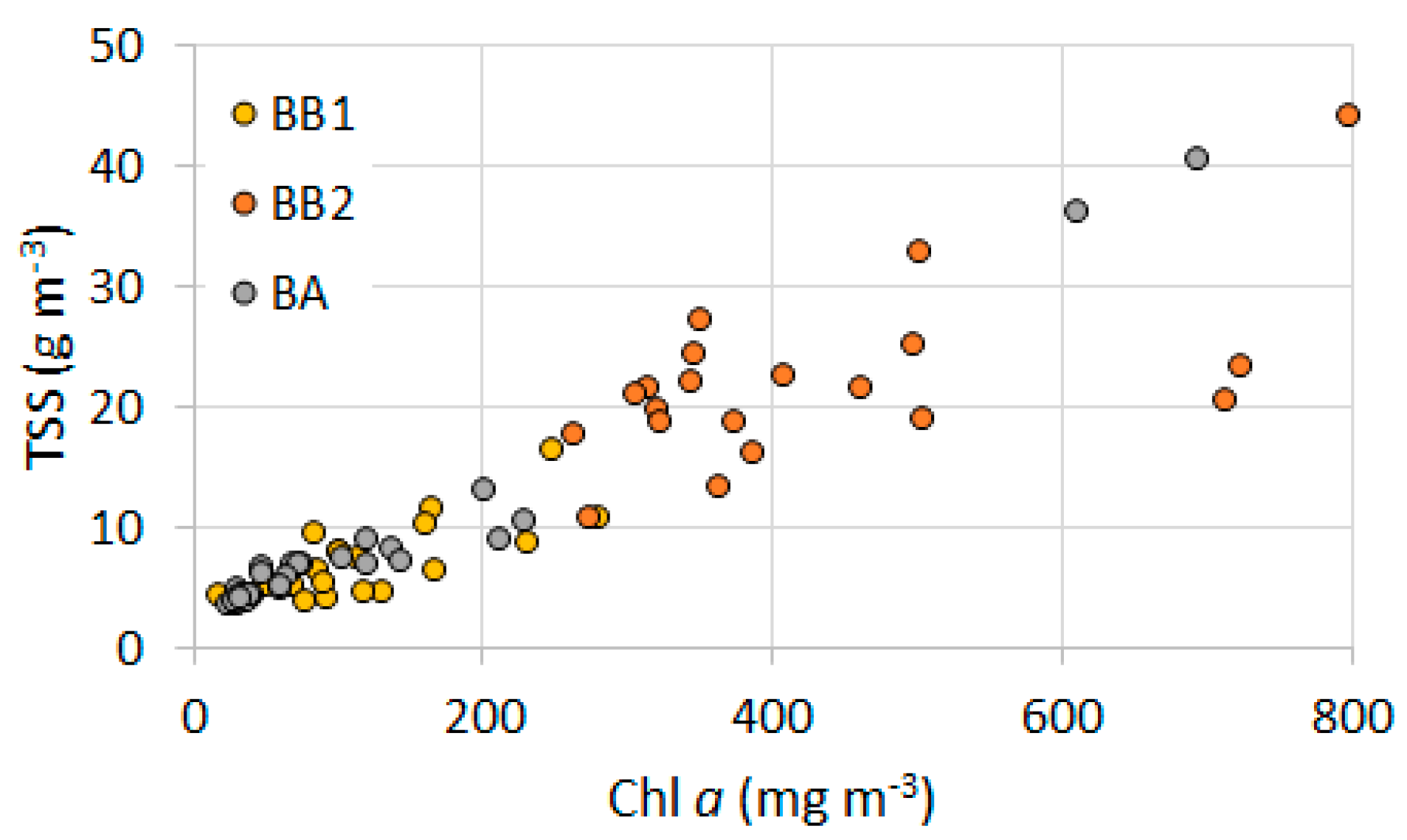
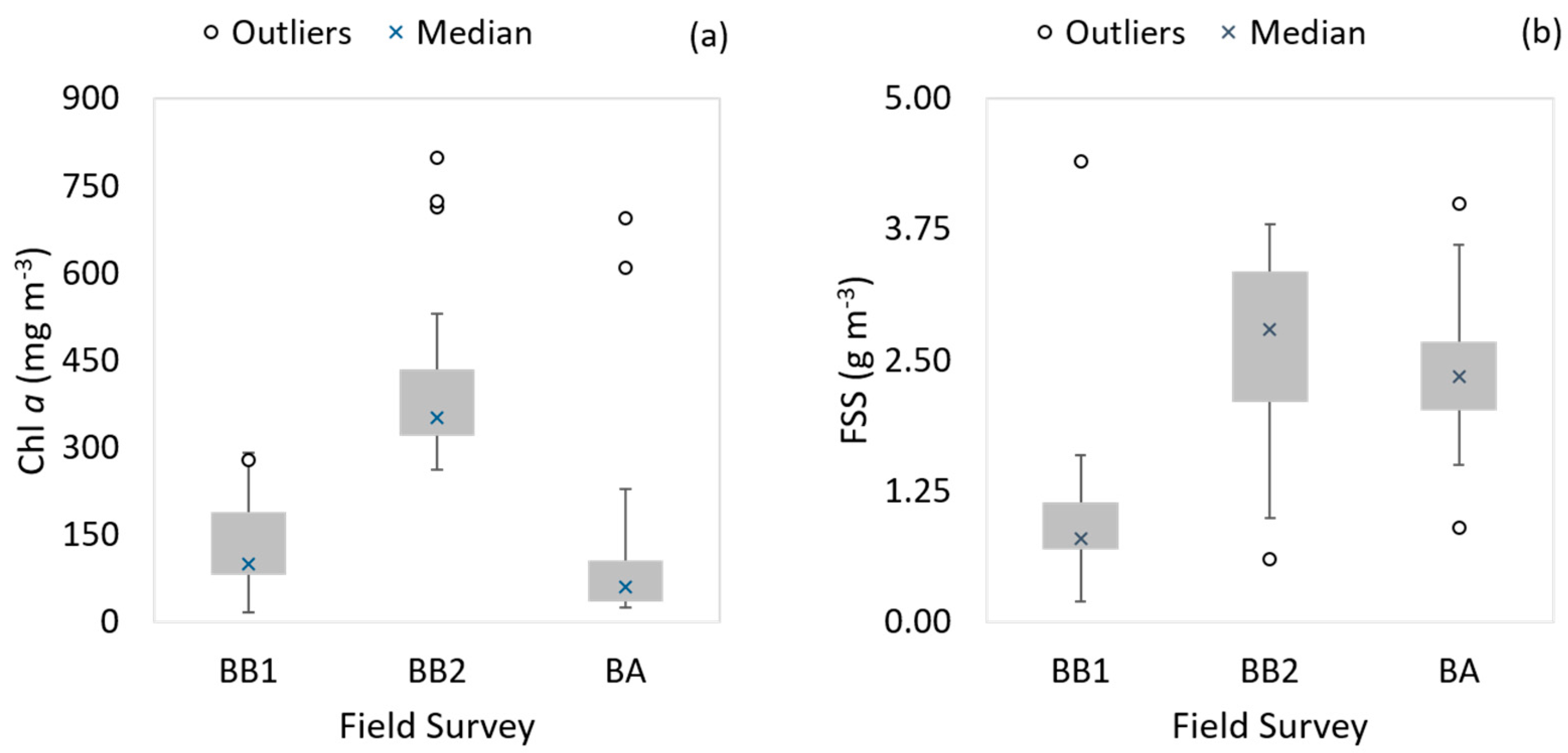

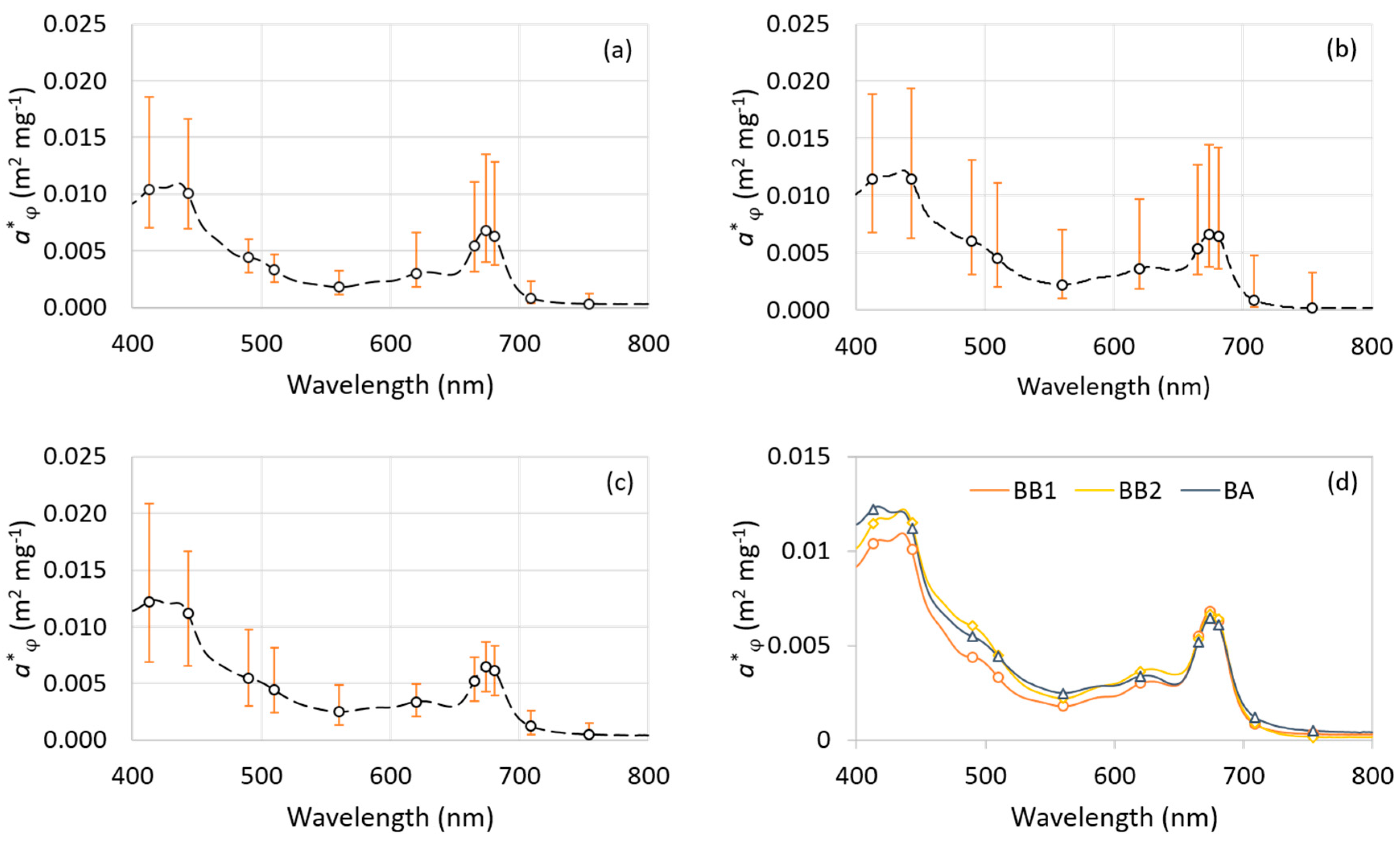

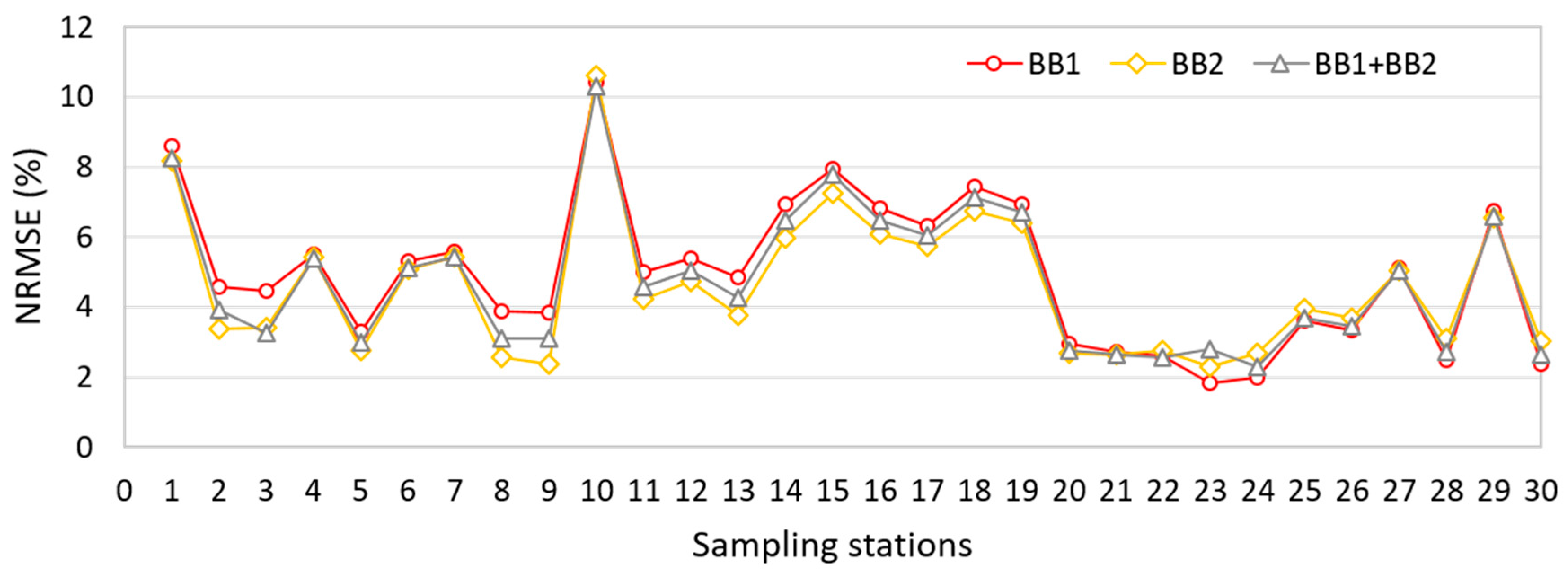



| Symbols | Definition | Unit |
|---|---|---|
| A | Total absorption coefficient, aw + aφ + aCDOM | m−1 |
| aCDOM | Absorption coefficient of colored dissolved organic matter | m−1 |
| aφ | Absorption coefficient of phytoplankton pigment | m−1 |
| aNAP | Absorption coefficient of non-algal particle | m−1 |
| aw | Absorption coefficient of pure water | m−1 |
| bb | Total backscattering coefficient | m−1 |
| bb,p | Backscattering coefficient of particles | m−1 |
| bb,w | Backscattering coefficient of pure water | m−1 |
| Γ | Geometrical factors | sr−1 |
| F | Geometrical light factor | - |
| Q | Light distribution factor | sr |
| Rrs | Remote sensing reflectance | sr−1 |
| Chla | Chlorophyll a | mg m−3 |
| CDOM | Colored dissolved organic matter | - |
| CDM | Colored detrital matter | - |
| NAP | Non-algal particle | g m−3 |
| AOP | Apparent optical property | - |
| IOP | Inherent optical property | m−1 |
| S | Spectral slope of aCDOM | nm−1 |
| TSS | Total suspended solids | g m−3 |
| FSS | Fixed suspended solids | g m−3 |
| VSS | Volatile suspended solids | g m−3 |
| u | Ratio of backscattering coefficient to the sum of absorption and backscattering coefficient | - |
| Y | Spectral power of bbp | - |
| Field | Statistic | Chl a | TSS | Chl a: TSS | ZSD |
|---|---|---|---|---|---|
| BB1 | Av (SD) | 119.8 (73.0) | 7.1 (3.4) | 16.6 (6.9) | 1.5 (0.5) |
| Min-Max | 17.7–279.9 | 3.6–16.3 | 4.0–27.9 | 0.8–2.3 | |
| BB2 | Av (SD) | 406.2 (137.1) | 20.7 (5.0) | 20.3 (6.8) | 0.6 (0.1) |
| Min-Max | 263.2–797.8 | 10.8–32.8 | 12.9–35.0 | 0.37–0.78 | |
| BA | Av (SD) | 117.12 (156.4) | 8.3 (8.4) | 12.1 (4.7) | 1.2 (0.3) |
| Min-Max | 25.1–694.3 | 3.6–40.3 | 6.3–23.9 | 0.5–1.6 |
© 2018 by the authors. Licensee MDPI, Basel, Switzerland. This article is an open access article distributed under the terms and conditions of the Creative Commons Attribution (CC BY) license (http://creativecommons.org/licenses/by/4.0/).
Share and Cite
Watanabe, F.; Alcântara, E.; Imai, N.; Rodrigues, T.; Bernardo, N. Estimation of Chlorophyll-a Concentration from Optimizing a Semi-Analytical Algorithm in Productive Inland Waters. Remote Sens. 2018, 10, 227. https://doi.org/10.3390/rs10020227
Watanabe F, Alcântara E, Imai N, Rodrigues T, Bernardo N. Estimation of Chlorophyll-a Concentration from Optimizing a Semi-Analytical Algorithm in Productive Inland Waters. Remote Sensing. 2018; 10(2):227. https://doi.org/10.3390/rs10020227
Chicago/Turabian StyleWatanabe, Fernanda, Enner Alcântara, Nilton Imai, Thanan Rodrigues, and Nariane Bernardo. 2018. "Estimation of Chlorophyll-a Concentration from Optimizing a Semi-Analytical Algorithm in Productive Inland Waters" Remote Sensing 10, no. 2: 227. https://doi.org/10.3390/rs10020227




